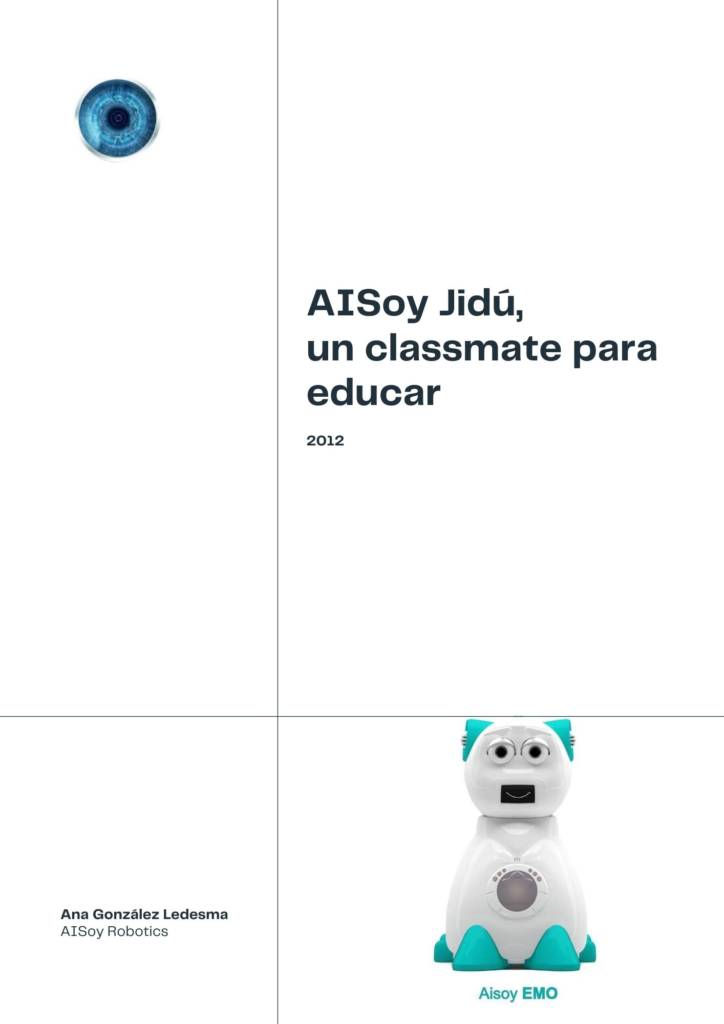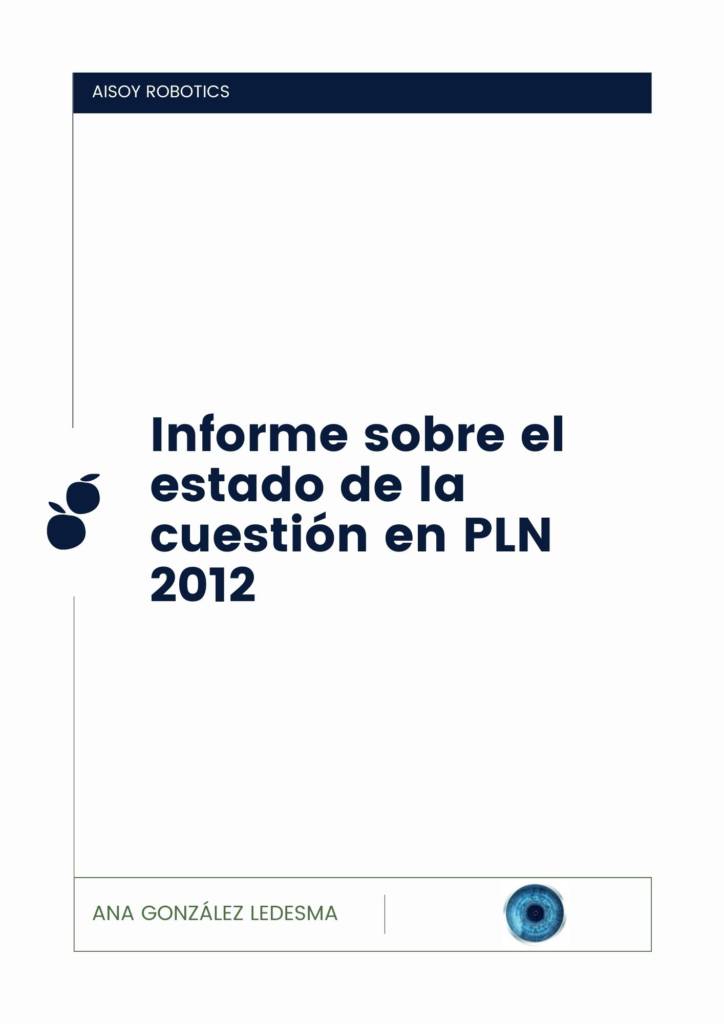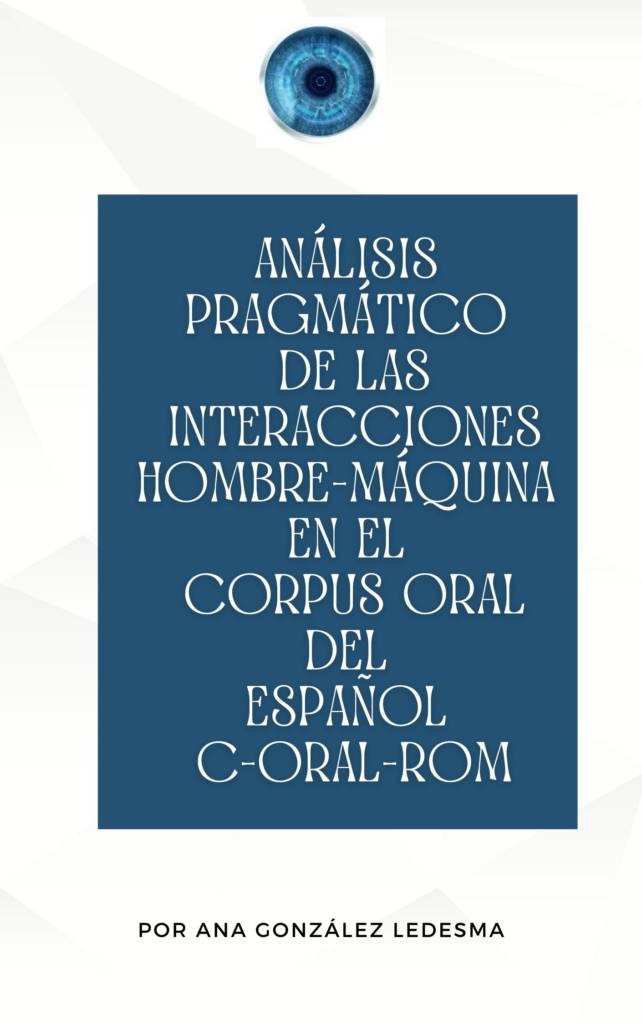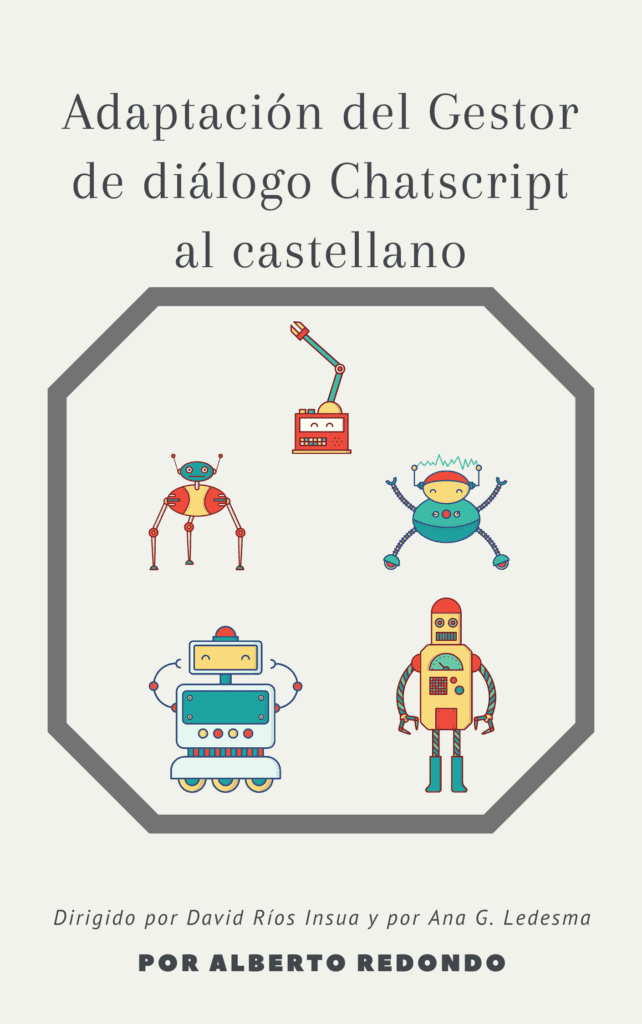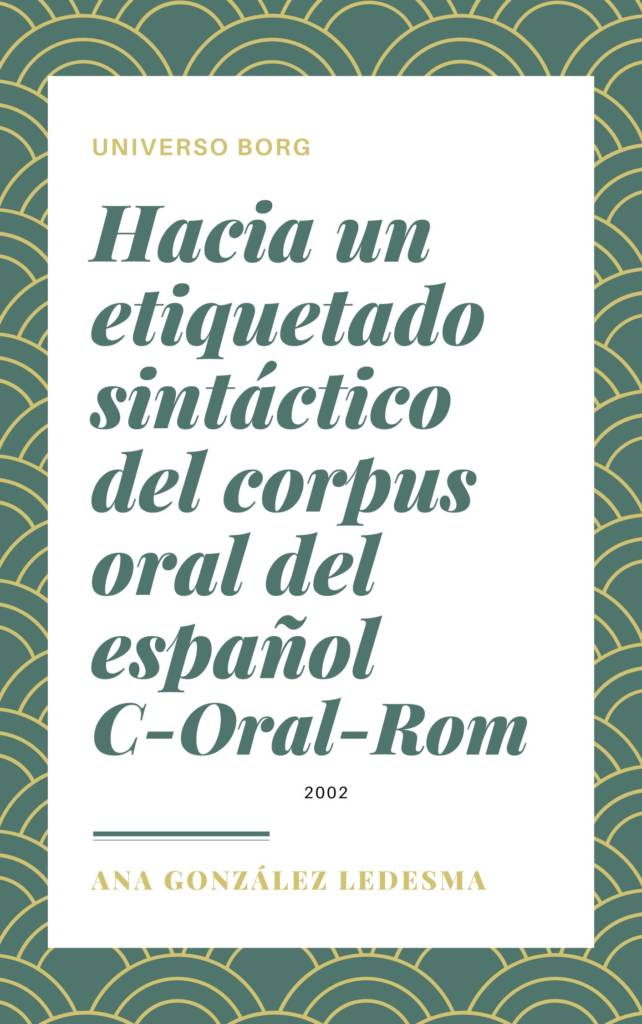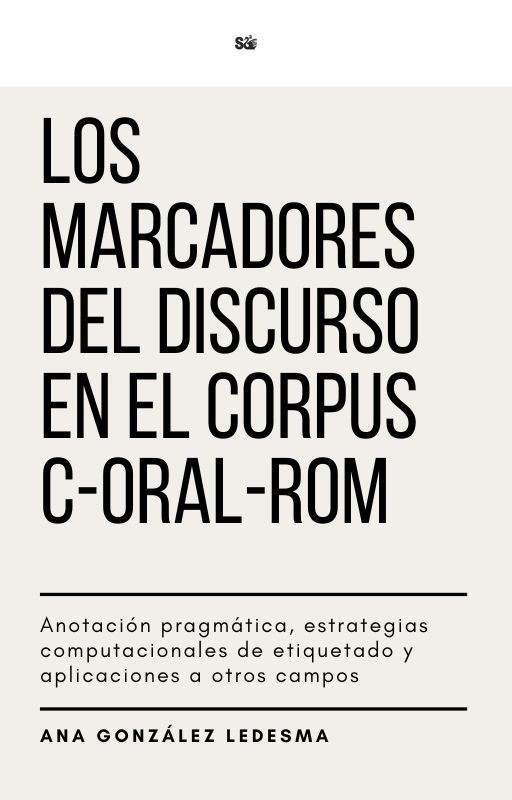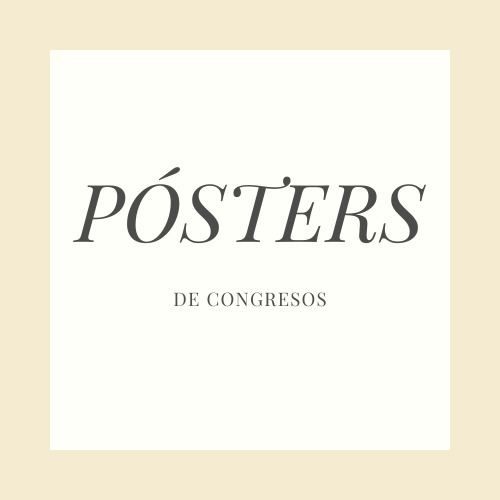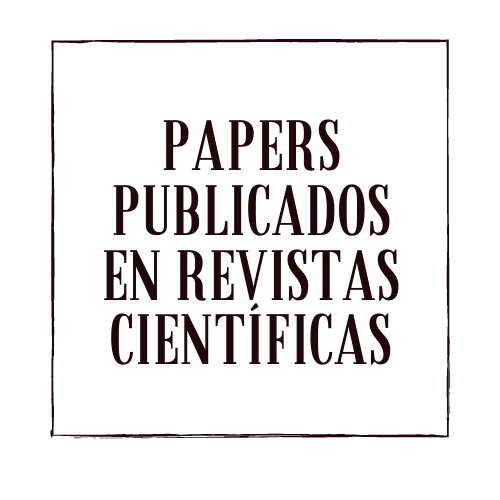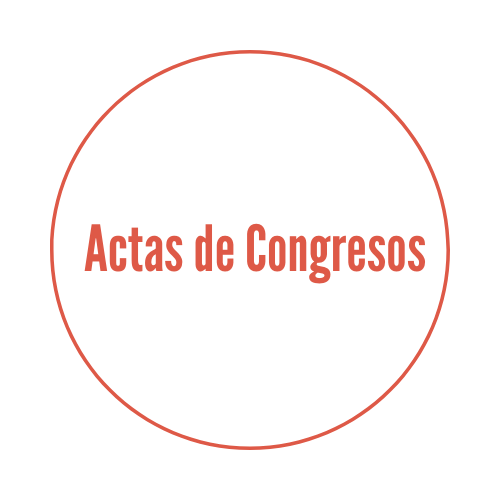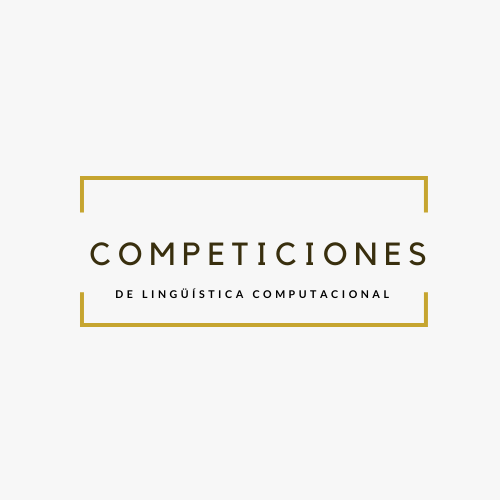Reformulación y atenuación: los operadores de modalización o sea y bueno en el corpus oral del español C-ORAL-ROM
Significado y valores semánticos del marcador o sea Para este primer acercamiento al significado y usos de la partícula o sea, hemos elegido como punto de partida el estudio realizado por Félix-Brasdefer (2006) sobre los usos del o sea en el español de México. En este artículo, se analizan los valores de este marcador a […]
Reformulación y atenuación: los operadores de modalización o sea y bueno en el corpus oral del español C-ORAL-ROM
Conclusiones y bibliografía Lo que hemos pretendido hacer en este pequeño estudio ha sido acercarnos a los diferentes valores de un mismo marcador discursivo desde una perspectiva más accesible a los alumnos extranjeros como son las estrategias que uno puede utilizar a la hora de comunicarse con otra persona. Estos marcadores funcionan como reguladores de […]
Reformulación y atenuación: los operadores de modalización o sea y bueno en el corpus oral del español C-ORAL-ROM
Atenuación y reformulación: operaciones de modalización La modalización es una operación que el hablante realiza cuando adopta una determinada actitud tanto frente al contenido de su enunciado como frente a su interlocutor. Dentro de las causas por las que el hablante decide emplear esta estrategia frente a lo dicho, Fouilloux (2005) señala las siguientes: 1) […]
Reformulación y atenuación: los operadores de modalización o sea y bueno en el corpus oral del español C-ORAL-ROM
Diferencias entre o sea y bueno O sea y bueno son marcadores diferentes porque reformular y atenuar son operaciones que también lo son. En el primer caso, una realidad se expresa en términos de otra, que en principio se considera más relevante o más cortés; en el segundo caso, en el de bueno, se presenta […]
Reformulación y atenuación: los operadores de modalización o sea y bueno en el corpus oral del español C-ORAL-ROM
Reformulación de una secuencia discursiva (18) *ELE: y entonces él me dijo / no // tienes razón // la verdad que … sabes ? que / yo / prefiero no llevarte // y dije vale // me parece estupendo // total / que / cuando volví de Munich / vi que + no / me […]
Reformulación y atenuación: los operadores de modalización o sea y bueno en el corpus oral del español C-ORAL-ROM
El radio de acción de los marcadores o sea y bueno: estudio contrastivo Solo en Cortés (2005), estos dos marcadores se clasifican juntos como marcadores textuales de progresión temática que mantienen una relación jerárquica unidireccional con los enunciados que conectan, esto es, reformuladores que a su vez se clasifican, según sus usos, en rectificadores (no […]
Reformulación y atenuación: los operadores de modalización o sea y bueno en el corpus oral del español C-ORAL-ROM
Modalizar reformulando con o sea Según Fuentes (1995), la reformulación es una operación enunciativa que muestra el control de la comunicación por parte del hablante. Siguiendo a esta autora, la operación de reformulación se podría dividir en tres etapas: 1) el hablante expresa un acto enunciativo X 2) una vez comunicado dicho acto, el hablante […]
Reformulación y atenuación: los operadores de modalización o sea y bueno en el corpus oral del español C-ORAL-ROM
Modalizar atenuando con bueno La atenuación es una subcategoría de la modalización mediante la cual el locutor restringe el alcance de lo dicho (Fouilloux, 2005). Esta estrategia discursiva se puede expresar a través de marcas morfológicas o léxicas tales como el sintagma en mi opinión, los verbos modales (poder), o también algunas formas verbales como, […]
Reformulación y atenuación: los operadores de modalización o sea y bueno en el corpus oral del español C-ORAL-ROM (5)
Significado y valores del marcador bueno Con el marcador discursivo bueno sucede exactamente lo mismo. Los autores consultados distinguen las siguientes funciones discursivas o valores semánticos, dependiendo de la escuela en la que nos adentremos[1]: Función pragmática: ratificación, conformidad, concesión, aceptación Función metadiscursiva: reanudación o continuidad temática, rectificación. Función expresiva: resignación, ironía. Como decíamos para […]
Reformulación y atenuación: los operadores de modalización o sea y bueno en el corpus oral del español C-ORAL-ROM (4)
Significado y valores semánticos del marcador o sea Para este primer acercamiento al significado y usos de la partícula o sea, hemos elegido como punto de partida el estudio realizado por Félix-Brasdefer (2006) sobre los usos del o sea en el español de México. En este artículo, se analizan los valores de este marcador a […]
Reformulación y atenuación: los operadores de modalización o sea y bueno en el corpus oral del español C-ORAL-ROM (3)
C-ORAL-ROM: descripción del corpus y herramientas computacionales de trabajo C-ORAL-ROM Madrid es el corpus de referencia que hemos utilizado para realizar el análisis de estos marcadores. La elaboración de este corpus ha sido llevada a cabo por el Laboratorio de Lingüística Informática de la Universidad Autónoma de Madrid (http://www.lllf.uam.es) y su desarrollo forma parte de […]
Reformulación y atenuación: los operadores de modalización o sea y bueno en el corpus oral del español C-ORAL-ROM (2)
Introducción Es un hecho conocido por todos que el estudio de los marcadores del discurso se hace cada vez más imprescindible en la enseñanza de español a extranjeros (ELE). La Pragmática, desde sus diferentes prismas teóricos y escuelas, ha descrito y sistematizado el significado de dichas partículas. En este sentido, los marcadores o sea y […]
Reformulación y atenuación: los operadores de modalización o sea y bueno en el corpus oral del español C-ORAL-ROM (1)
Abstract Con el fin de facilitar el aprendizaje de los marcadores discursivos en las aulas de español para extranjeros, en este artículo se analizan de forma contrastiva, y a través de la consulta del corpus C-ORAL-ROM, los marcadores discursivos o sea y bueno como piezas léxicas que forman parte de estrategias pragmático-discursivas más generales como […]
Pragmatic Annotation of Discourse Markers in a Multilingual Parallel Corpus (Arabic- Spanish-English) (4)
Theoretical Framework Studies in Pragmatics revealed that the communication process is carried out at the inferential level, i.e., the communication process is no longer regarded as a process of encoding and decoding the information, but as a process where the interpretation of the world of the speaker is encoded, transmitted, decoded and finally interpreted again […]
Pragmatic Annotation of Discourse Markers in a Multilingual Parallel Corpus (Arabic- Spanish-English) (3)
Work Outlines The present study is organized as follows. After this introductory section, in the second part, we explain the guidelines defining our theoretical pragmatic framework. Based on this framework, in the third section, we describe the typology adopted in the classification of the discourse markers and how it is reflected through the PRAGMATEXT, the […]
Pragmatic Annotation of Discourse Markers in a Multilingual Parallel Corpus (Arabic- Spanish-English) (3)
Motivation Discourse markers have been subject of different studies in the field of computational pragmatics and natural language processing. especially in applications concerned with the detection of document structure for automatic summarization or for the interpretation and generation of speech acts in speech corpora and dialogue systems (Kawahara & Hasegawa, 2002). However, most of these […]
Pragmatic Annotation of Discourse Markers in a Multilingual Parallel Corpus (Arabic- Spanish-English) (2)
Introduction Pragmatics is usually defined as the study of how language is used. In the language use, context plays a key role in the interpretation of statements. That is the reason why Pragmatics is concerned, among other topics, with Inference. Through this mental process, humans can obtain information that is not actually present in the […]
Pragmatic Annotation of Discourse Markers in a Multilingual Parallel Corpus (Arabic- Spanish-English) (1)
ABSTRACT Discourse structure and coherence relations are one of the main inferential challenges addressed by computational pragmatics. The present study focuses on discourse markers as key elements in guiding the inferences of the statements in natural language. Through a rule-based approach for the automatic identification, classification and annotation of the discourse markers in a multilingual […]
PRAGMATEXT (6): Conclusions and future work
In this paper, a pragmatic annotation model and its implementation in XML language is presented. Currently the spontaneous spoken corpus CORALROM has been tagged. This is a corpus with a wide range of communicative situations and a large number of linguistic registers. The pragmatic phenomena tagged are emotions, discourse relations, modalization, evidentiality, phraseological units, metaphor […]
PRAGMATEXT (6)
PRAGMATEX in XML To formalize an annotation model in a Schema or DTD in XML language, there is a need to define what information will be introduced in the attribute labels and in the elements label. The application of the annotation model to the Schema is based on the principles below. The preferred option has […]
PRAGMATEXT (5)
PRAGMATEXT TAGSET The phenomena described here are: Each phenomenon described is analyzed according to the methodology adopted to design of the tagset: description of Pragmatic phenomenon; classification of pragmatic categories; inventory of lexical linguistic forms in which a phenomenon is codified and formalization in XML language. Emotional discourse The analysis of emotions has been addressed […]
Pragmatext (4)
A pragmatic annotation model All phenomena described here have a cognitive origin, hence they are universals. A cognitive phenomenon influences social interaction and language. Therefore, the verbal communication process can be analyzed from three closely related levels: cognitive social, pragmatic and linguistic. At a cognitive social level, the theoretical framework described is based on the […]
PRAGMATEXT (3)
C-ORAL-ROM, a spontaneous spoken corpus The corpus used for the present study is developed within the framework of the European project C-Oral-Rom. The main goal of this project was to build four corpora in four romance languages (Italian, Spanish, French and Portuguese) with similar design features: the same number of words, the same types of […]
PRAGMATEXT (2)
Introduction Pragmatics is the science of the use of language in its context. In the second half of the 20th century, linguists and philosophers started to study the importance of context in the interpretation of statements. There have been two areas of progress in this field: the study of spoken language and the conception of […]
PRAGMATEXT: Annotating the C-ORAL-ROM Corpus with Pragmatic Knowledge (1)
This paper outlines the first phase of the PRAGMATEXT project. The aim of PRAGMATEXT is to introduce pragmatic knowledge into the transcriptions of C- ORAL-ROM, a spontaneous spoken corpus of Spanish. The paper is divided in four sections. The first section presents the most relevant features of the C-ORAL-ROM corpus. The second describes the pragmatic-discursive […]
Orality and Difficulties in the Transcription of Spoken Corpora (6)
Textual typology and transcription problems: analysis of the data In this section, the results obtained by the program are analyzed. The analysis procedure has always been the same for each of the linguistic phenomena studied: First, the relation between frequency of occurrence of the features and textual typology is stated. Second, we evaluated whether this […]
Orality and Difficulties in the Transcription of Spoken Corpora (5)
The computational tool The C-ORAL-ROM corpus is tagged with XML. Using the information included in the tags, we developed a program which automatically calculate the frequency of occurrence of each of the following features: overlapping, retracting, number of dialogic turns, speaking speed, fragmented words and supports. These frequencies were calculated for each class of texts. […]
Orality and Difficulties in the Transcription of Spoken Corpora (4)
Orality and transcription problems: the original hypothesis In order to find out what kind of relation there is between orality and linguistic registers, two scales of transcription difficulty were stated taking into consideration the following two parameters: Degree of formality (Scale 1) Two ends can be considered when dealing with the texts in terms of […]
Orality and Difficulties in the Transcription of Spoken Corpora (3)
The notion of orality It is well known that spoken language is not always a synonym to orality, if we understand orality as the presence of linguistic, paralinguistic and interactive phenomena, such as retracting or overlapping, which are not present in the written register. The registers in spoken language vary depending on the communicative situation. […]
Orality and Difficulties in the Transcription of Spoken Corpora (2)
Description of the corpus C-ORAL-ROM is a multilingual spontaneous speech corpus (Cresti et al., 2002) of the four main roman languages: French, Italian, Portuguese and Spanish. Each subcorpus consists of around 300,000 words. With the aim of enabling comparability between the different subcorpora, several sampling criteria concerning the distribution of the corpus were established: as […]
Orality and Difficulties in the Transcription of Spoken Corpora (2)
1. Introduction This paper is the result of an experiment carried out by a group of transcribers at the Laboratorio de Lingüística Informática (LLI) at the Universidad Autónoma de Madrid, once the recording and transcribing phases of the C-ORAL-ROM project were over. The goal of the experiment was to confirm certain hypothesis which had arisen […]
Orality and Difficulties in the Transcription of Spoken Corpora (1)
Abstract This paper analyses the effects of certain oral features on the process of transcription of spontaneous speech recordings. On the basis of the statistical analysis of the data obtained from the C-ORAL-ROM corpus, it will be shown empirically that transcription difficulties vary according to the communicative situation, the degree of formality and the number […]
Pragmatic analysis of man-machine interactions in a spontaneous speech corpus (5)
Conclusions and Future Work The results are approximately 60 % failures and 40 % success. Behind these figures lay the other’s image and the expectations, both from the speaker and from the machine. One of the principles that makes human communication possible is that speakers are able to adapt their speech acts to the expectations […]
Pragmatic analysis of man-machine interactions in a spontaneous speech corpus (4)
Analysing the interactions System evaluation The first step had been to measure the degree of real success of the dialog system. As the phone calls were intended only for scientific purposes and the speakers proposed fictitious destinations, it is not easy to define what “success” mean. As we will see later, some speakers change their […]
Pragmatic analysis of man-machine interactions in a spontaneous speech corpus (3)
The man-machine telephone corpus For this paper, we have only considered the small subset of human-machine telephone recordings, part of the telephone corpus. This subset has been collected by means of an automatic telephone call system specifically designed and developed for the C-ORAL- ROM project by ITC-Irst (Falavigna & Gretter 2003). The system handles interactions […]
Pragmatic analysis of man-machine interactions in a spontaneous speech corpus (1)
Introducción The goal of this paper is to analyse man-machine interactions in the Spanish data of C- ORAL-ROM, a multilingual, multimedia corpus of spontaneous speech. The subcorpus consists of 41 recordings, over 2600 words. The issue we want to address is why some of the interactions succeeded, while most of them resulted in misunderstandings and […]
Pragmatic analysis of man-machine interactions in a spontaneous speech corpus (2)
1. The C-ORAL-ROM corpus C-ORAL-ROM is a multilingual spontaneous speech corpus that comprises four romance languages: Italian, French, Portuguese and Spanish (Cresti & Moneglia 2005). In our work we have used the Spanish sub-corpus, which contains around 300.000 spoken words. From a sociolinguistic point of view, speakers are characterized by their age, gender, place of […]
Marcadores discursivos en árabe y español (10)
5. Conclusiones y trabajo futuro Hemos presentado en este artículo una aproximación al campo de los marcadores discursivos desde una perspectiva computacional. Hemos apostado por un modelo de anotación pragmática basado en fenómenos de naturaleza cognitiva y social, y que remiten al conocimiento generado en la Pragmática de corte teórico. La motivación principal es, por […]
Marcadores discursivos en árabe y español (9)
Los marcadores discursivos del corpus árabe de la ONU Para la anotación de los marcadores discursivos en árabe, se ha desarrollado un módulo de procesamiento que tiene como entrada tres fuentes de información: Para la última fuente de información, la lista de marcadores discursivos españoles se ha traducido automáticamente a través de un sistema de […]
Marcadores discursivos en árabe y español (8)
Los marcadores discursivos en el corpus español de la ONU Llegamos por tanto a la etapa del reconocimiento y etiquetado de los marcadores discursivos en un texto de habla oral. Para la resolución de esta tarea debemos plantearnos cómo vamos a gestionar el problema de la ambigüedad de los marcadores discursivos, una ambigüedad que como […]
Marcadores discursivos en árabe y español (7)
Pragmatext y los marcadores discursivos: una perspectiva teórica y computacional En este trabajo hemos intentado trazar un puente de comunicación entre la Pragmática Lingüística y la Pragmática Computacional en lo que al tratamiento de los marcadores discursivos se refiere. Buena parte de este compromiso pasa por adoptar una postura coherente con respecto a los siguientes […]
Marcadores discursivos en árabe y español (6)
Pragmatext, un modelo de anotación pragmática para corpus A continuación presentamos muy resumidamente los cimientos teóricos en los que se sustenta nuestro modelo de anotación. Las fuentes de conocimiento en las que está basada esta concepción teórica pertenecen a los últimos descubrimientos en el estudio de la interacción mente-cuerpo por parte de las Ciencias Cognitivas […]
Marcadores discursivos en árabe y español (5): El corpus de la ONU: diseño y características
Para este estudio, hemos utilizado un corpus paralelo bilingüe español-árabe, formado por una colección de textos disponibles en Internet procedentes de los documentos de la Organización de las Naciones Unidas. Términos como “corpus paralelo”, “corpus de traducción” y “corpus comparable” pueden resultar ambiguos en algunos casos; por ello, conviene destacar cuál ha sido nuestra concepción […]
Marcadores discursivos en árabe y español (4): Introducción
Presentamos en este trabajo un estudio de carácter interdisciplinar donde participan diversas áreas de conocimiento: la Pragmática Lingüística, la Traducción, la Lingüística Contrastiva apoyada en Corpus Paralelos y la Lingüística Computacional.Es un hecho conocido que la Pragmática, desde sus diferentes marcos teóricos, ha puesto de manifiesto la importancia que los marcadores discursivos tienen a la […]
Marcadores discursivos en árabe y español (3): tabla de contenidos
Tabla de contenidos 3.5. Deixis
Marcadores discursivos en árabe y español: un estudio computacional basado en corpus paralelos con anotación pragmática (2): abstract en inglés
This article presents an analysis of the translation of Discourse Markers in a parallel Spanish-Arabic corpus from a computational perspective. The research carried out is divided into three main sections. The first section describes the resources used in the study including the main characteristics of the corpus and the pragmatic annotation model (PRAGMATEXT) used in […]
Marcadores discursivos en árabe y español: un estudio computacional basado en corpus paralelos con anotación pragmática (1): abstract
El objetivo de este artículo ha sido el de analizar el modo en que se ha llevado a cabo la traducción de los marcadores discursivos del árabe y del español en el corpus paralelo de la ONU desde una perspectiva computacional. La investigación está dividida en tres partes. La primera de ellas está dedicada a […]
MIRACLE Question Answering System for Spanish at CLEF 2007 (1): Abstract
This paper describes the system developed by MIRACLE group to participate in the Spanish monolingual question answering task at QA@CLEF 2007. A basic subsystem, similar to our last year participation, was used separately for EFE and Wikipedia col- lection. Answers from the two subsystems are combined using temporal information from the questions and the collections. […]
MIRACLE at the Spanish CLEF@QA 2006 track (1): abstract
We describe the prototype QA system built by MIRACLE group, a group composed by three Madrid universities and the spin-off, DAEDALUS. The system is an elaboration of our last year system with several improvements in question analysis and NERC components. We submitted two runs for the Spanish runs with different strategies to use NE in […]
MIRACLE Experiments in QA@CLEF 2006 in Spanish: Main Task, Real-Time QA and Exploratory QA Using Wikipedia (WiQA) (1): abstract
We describe the participation of MIRACLE group in the QA track at CLEF. We participated in three subtasks and presented two systems that works in Spanish. The first system is a traditional QA system and was evaluated in the main task and the Real-Time QA pilot. The system features improved Named Entity recognition and shallow […]
Relating Lexical Items to Sociolinguistic Features in a Spontaneous Speech Corpus of Spanish
This paper shows the application of statistical tests to a spontaneous speech corpus of Spanish. Our goal is to find representative differences between different parts of the corpus. To this end, we tagged n-grams in the corpus with features related to the speaker (age, gender, etc), or the context (dialogue, monologue, media, etc), and applied […]
MIRACLE’s Cross-Lingual Question Answering Experiments with Spanish as a Target Languages: Descripción del sistema
System Description MIRACLE’s contribution to CLEF QA 2005 is an almost new development based on the experience acquired after last year. Our aim was to achieve an architecture where we could do further experiments and perform semi-automatic evaluation with the resources generated at previous CLEF editions like MultiEight. The system is composed of Question Analysis, […]
MIRACLE’s Cross-Lingual Question Answering Experiments with Spanish as a Target Languages 2: Introducción
This paper presents and analyzes the results of our second participation in the CLEF-QA task. At this moment, miraQA, is based on a standard pipeline ar- chitecture and uses only shallow linguistic analysis. In contrast, we have added semantic resources for NE recognition. The approach and tools differ from our last year participation[2] but we […]
MIRACLE’s Cross-Lingual Question Answering Experiments with Spanish as a Target Languages 1: abstract
Our second participation in CLEF-QA consited in six runs with Spanish as a target language. The source languages were Spanish, English an Italian. miraQA uses a simple representation of the question that is enriched with semantic information like typed Named Entities. Runs used different strategies for answer extraction and selection, achiev- ing at best a […]
Relating Lexical Items to Sociolinguistic Features in a Spontaneous Speech Corpus of Spanish
This paper shows the application of statistical tests to a spontaneous speech corpus of Spanish. Our goal is to find representative differences between different parts of the corpus. To this end, we tagged n-grams in the corpus with features related to the speaker (age, gender, etc), or the context (dialogue, monologue, media, etc), and applied […]
LA ORGANIZACIÓN IDEAL: Introducción al software meta-organizativo
Presentamos en esta comunicación, la aplicación informática META-ORGANÍZATE, una api de software meta-organizativo que sirve para que las redes sociales diseñen su organización ideal. Este es un proyecto de la empresa social de tecnologías del lenguaje S.XXII y del grupo de investigación en tecnologías para la utopía, El Ateneo TecnoUtópico y surge al detectar el […]
Inteligencia computacional y Big Data en la Neorrevolución política, económica y educativa
El objetivo de este artículo es el de presentar los desafíos intelectuales que la inteligencia artificial necesita abordar para hacer posible un nuevo mundo post-capitalista, cuyo sistema persiga la felicidad del ser humano y no el dinero. Hablaremos de dichos retos centrándonos en tres campos de aplicación: la educación, la política y la economía. En […]
¿No se inventó nada contra la normalidad? El sentido del humor en Mafalda: un análisis pragmático
El presente artículo tiene por objeto analizar el sentido del humor verbal en Mafalda desde una perspectiva pragmática. Bajo este marco, estudiaremos dos recursos claves en el sentido del humor de nuestro personaje: el uso que Mafalda hace de la fraseología, y el valor comunicativo que para nuestro personaje tienen las preguntas. Las unidades fraseológicas […]
Nuevos marcos para el concepto de identidad cultural: la democracia electrónica 4.0.
El objetivo de este artículo es el de presentar una aplicación informática para que los usuarios puedan proponer y votar a través de democracia electrónica directa patrones de identidad cultural con el fin de que dichos patrones de información puedan ser implementados en la arquitectura cognitiva del robot emocional AISoy. Con este proyecto se pretende […]
Análisis pragmático de las interacciones hombre-máquina en el corpus oral del español C-ORAL-ROM.
El objetivo de este artículo es el de evaluar los resultados de las interacciones entre hombre-máquina pertenecientes al corpus oral del español C-ORAL-ROM, en las cuales los hablantes llaman por teléfono a un servicio automático de información de trenes y establecen con él un diálogo en torno al horario, el lugar de partida, de llegada […]
AISoy Jidú, un classmate para hacer las tareas del cole
El sistema educativo está considerado por buena parte de los teóricos de la educación como anacrónico y está siendo fuertemente criticado por los siguientes motivos: Para terminar de contextualizar el panorama educativo, no debemos dejar de reseñar que los nuevos cambios en política económica dejan a la educación pública en una situación difícil, con graves […]
Informe PLN para el proyecto de la casa inteligente HAUS: Breve historia de la lingüística
La Lingüística comienza a fijarse en el estudio de la lengua como un sistema estructurado con categorías y reglas a partir del siglo XX. Antes, los lingüistas ocuparon su tiempo en estudiar la lengua desde un punto de vista diacrónico, esto es, las lenguas en evolución, organizándola al más puro estilo darwiniano en familias, con […]
Análisis corpus hombre-máquina: fase de investigación
Durante la realización de esta investigación, fuimos analizando las razones del éxito y el fracaso de la interacción de los hablantes con el sistema de reserva de billetes de tren INFOTREN. etelmm02 resumen La hablante sabe que está hablando con una máquina, dice sí y no, de forma parca y concisa. Solo que sabe que […]
Robots para educar: La crisis del sistema educativo
El sistema educativo está considerado por buena parte de los teóricos de la educación como anacrónico y está siendo fuertemente criticado por los siguientes motivos: Para terminar de contextualizar el panorama educativo, no debemos dejar de reseñar que los nuevos cambios en política económica dejan a la educación pública en una situación difícil, con graves […]
Retrato del profesor y doctor Daniel Israel Fliguer
Daniel Adrián Israel Fliguer, 2006, Madrid, España.
Corpus de usuario de AISoy: participantes
En el año 2012, el robot AISoy se puso en el mostrador de un antiguo videoclub en la provincia de Cádiz, en el Sur de España. Allí los usuarios acudían e interactuaban con el robot. Fruto de estas interacciones la autora realiza un informe sobre la forma de comportarse de unos habitantes de un pequeño […]
TFM 5: ChatScript
Es uno de los GD más completos existentes en la actualidad diseñado para acep-tar texto del usuario y generar texto como respuesta, ChatScript (CS) es la nueva6generación de máquinas de ChatBot, ganó el premio Loebner en 2010 con Suzette, elmismo premio en 2011 con Rosette y consiguió 2o puesto con Angela en 2012. CS in-cluye […]
TFM 4: Cleverbot
Es un GD basado en inteligencia artificial, capaz de aprender de conversaciones gra-cias a la base de datos que incluye, formada por respuestas de personas de diferentespaı́ses. Se caracteriza por su capacidad de adaptación a las conversaciones en difer-entes idiomas. Participó en un test de Turing formal en 2011, obteniendo una califi-cación de ser humano […]
Adaptación del Gestor de Diálogo Chatscript al Castellano 3: Algunos gestores de diálogo, Rivescript
Actualmente, existen gestores de diálogo muy potentes que han ido mejorando a largodel tiempo. Entre los más conocidos se encuentran: Rivescript Es un GD que consigue aportan inteligencia a un robot para chatear con otras enti-dades conversacionales. Empezó siendo un módulo Perl denominado Chatbot Alphaen 2004, programado por Kirsle. Este habı́a estado trabajando con chaterbots […]
Adaptación del Gestor de Diálogo Chatscript al Castellano 1: Introducción
Un sistema de diálogo o agente conversacional (CA), es un sistema computacional dirigi-do a conversar con personas con una estructura coherente. Los sistemas de diálogo empleantexto, discursos, gráficos, gestos y otros modos de comunicación en canales de entrada yde salida. El funcionamiento básico se puede ver en la figura 1.1. Existen diferentes arqui-tecturas para los […]
Adaptación del Gestor de Diálogo Chatscript al Castellano 2: Gestores de Diálogo
Los Gestores de Diálogo (GD) se utilizan en la actualidad en diferentes medios comoasistentes telefónicos, asistentes en gasolineras o en centros médicos. El ciclo de actividadhabitual en el que entra en funcionamiento un gestor de diálogo, comprende las siguientesfases:El usuario habla con el sistema y la entrada de datos se convierte en texto planomediante un […]
Hacia un etiquetado sintáctico del corpus Coral Rom 1: Introducción
C-ORAL-ROM (1): Introducción El objetivo de este estudio es desarrollar un sistema de etiquetado con información sintáctica para el corpus oral del español C-ORAL-ROM Madrid. Por anotación entendemos la inserción de marcas o etiquetas que identifiquen información dentro del texto Moreno (2000). Para que un corpus sea útil no solo tiene que registrar un número […]
Resumen en español de la tesis doctoral sobre Pragmática computacional
En este trabajo presentamos un esquema de anotación pragmática para corpus (Pragmatext), un etiquetador semi-automático de marcadores del discurso (DiMaSTagger) y, finalmente, una aplicación web (Alter Alia) para lingüistas, informáticos y hablantes no nativos del español, a través de la cual se pueden consultar ejemplos de los marcadores del discurso del corpus oral del español […]
Abstract de la tesis en inglés
In this work, the discourse markers from the Spanish spoken corpus C-ORAL-ROM are been annotatedwith the pragmatic annotation model PRAGMATEXT. This anotation model is based on a system offeatures, where each feature corresponds with a semantic-pragmatic phenomenon: discoursive modalization, evidentiality, discourse relations, deixis and speech acts. This features will be activated in according on the […]
Las voces de la razón: retos para la relación entre mente y lenguaje
En primer lugar, me gustaría destacar que la dicotomía entre significado cognitivo y significado socio-cultural es tan útil metodológicamente como falsa en la realidad, ya que en el fondo la cultura forma parte de la cognición. Comenzando por esta última, la Teoría de la Relevancia, nos habla de qué ocurre con el significado y la […]
Puntos críticos y trabajo futuro
Forma parte del trabajo futuro, y por ende, de las limitaciones de la investigación realizada aquí, la integración del sistema de anotación pragmática dentro de una investigación mayor. En concreto, el Laboratorio de Lingüística Informática deberá en el futuro unificar todos sus esquemas de anotación, y todos sus etiquetadores (el categorial y el pragmático). Además, […]
Resumen y novedad del trabajo
Comencemos con un breve resumen de la investigación que se ha llevado a cabo en esta tesis. En primer lugar, nos gustaría destacar que este trabajo se ha ocupado fundamentalmente del problema de cómo gestionar los marcadores discursivos en un corpus concreto, C-Oral-Rom, en todas y cada una de sus etapas, desde la más puramente […]
Síntesis, conclusiones finales y trabajo futuro
Conclusiones finales y trabajo futuro Hemos llegado al final de la investigación. Vamos a estructurar la última sección de este trabajo en tres partes. En la primera de ellas haremos un resumen de los contenidos de la tesis y destacaremos el impacto o novedad de los conocimientos aquí presentados. En la segunda parte, expondremos lo […]
Inteligencia artificial y Pragmática: perspectivas de investigación
Una tecnología suficientemente avanzada es indistinguible de lo mágico. Arthur C. Clarke. Me gustaría comenzar este apartado apelando a la reflexión de la introducción en torno a la relación entre lenguaje natural y matemáticas. Creo que el debate fundamental en esta cuestión se centra en torno a los modelos matemáticos. A día de hoy, no estamos […]
Conclusiones capítulo 9
Conclusiones Llegamos al final de la segunda aplicación de un corpus anotado con información pragmática. En este capítulo hemos presentado las bases teóricas más importantes en la disciplina de la Enseñanza de español a alumnos extranjeros, y hemos diseñado una interfaz Web para introducir al alumno en el mundo de los marcadores del discurso y […]
El interfaz Web: Inter Alia
Una web está sustentada en el concepto de hipertexto a la hora de mostrar la información. El hipertexto activa la iniciativa del alumno en el aprendizaje en función de sus inquietudes o necesidades comunicativas. Ya señalamos en el apartado teórico la importancia de la agentividad del alumno en el proceso de aprendizaje. Lo que el […]
INTER ALIA, un interfaz Web para el aprendizaje de la pragmática: Declaración de principios
Primero de todo, me gustaría destacar las ideas principales en torno a las cuales va a girar la concepción de la aplicación informática que hemos desarrollado, y que pasaremos a enumerar a continuación y a desarrollar más detenidamente después:
La enseñanza de segundas lenguas con corpus
Los materiales didácticos muchas veces son el único input de datos con los que cuenta el alumno de L2. Un corpus se puede enfocar también como material didáctico para la enseñanza de lenguas, y además tiene el atractivo de ser muestras directas, reales de la lengua.Carlota Nicolás enseña español a alumnos italianos en la universidad de Florencia. Esta […]
La enseñanza de lenguas y el ordenador
A continuación enumeraremos las ventajas y desventajas que se han señalado respecto de la enseñanza de lenguas por ordenador ( y ):
Enseñanza de marcadores del discurso en ELE
Los marcadores del discurso son vistos como indicadores del nivel de dominio de la lengua del hablante no nativo y . Al mismo tiempo, los autores que se han ocupado de esta intereseccion disciplinar reconocen que la enseñanza de estas partículas constituye una de las carencias más graves que sufre actualmente la enseñanza de segundas lenguas . Entre […]
La enseñanza de la Pragmática y de los marcadores del discurso
¿Qué es la Pragmática? ¿Es el estudio del significado desde diferentes disciplinas? ¿Es una dimensión de estudio o un módulo de la gramática? ¿Es aquello que estudia la relación entre lo que el hablante quiere decir y lo que el receptor entiende? ¿Es lo que refleja las relaciones sociales? ¿Qué Pragmática enseñamos, la social o […]
Del enfoque por tareas
Este enfoque consiste en proporcionar un input al alumnado que le servirá no tanto como de modelo, sino como una muestra de lengua para analizar cómo se expresa una idea o sentimiento. A partir de este análisis y reflexión, el alumno será capaz de diseñar un productor final (outcome) como resultado de todo su proceso de aprendizaje . […]
Del enfoque comunicativo
De este enfoque, estas son las aportaciones más interesantes en lo que respecta a la mejor manera de aprender una lengua extranjera , e :
De las vertientes cognitivo-sociales de corte constructivista
La teoría cognitiva nace en el campo de la Psicología Cognitiva y se centra en el estudio del papel de los procesos cognitivos más generales involucrados en la adquisición de la lengua. A continuación, enumeramos las ideas más interesantes que ha aportado esta línea al conocimiento del aprendizaje de lenguas y :
Estado de la cuestión: ELE, Pragmática, ordenadores y corpus 1: Marcos teóricos y metodológicos para ELE
La historia metodológica en la enseñanza de lenguas extranjeras ha pasado por tres fases: el enfoque conductista, el enfoque comunicativo y el integrado. Este último modelo impera desde los años noventa y se basa en una visión de tipo más social o socio-cognitiva del aprendizaje, fundamentado en la psicología de Vigotsky de 1964, el cual […]
La enseñanza por ordenador de los marcadores del discurso a alumnos italianos con C-ORAL-ROM, un corpus del español oral: Introducción
En más de una ocasión la Unión Europea ha manifestado su preocupación por la creación de una sociedad multilingüe . Es posible que esa fuera, entre otras, una de las razones por las que financió la creación de estos corpus de habla oral con el proyecto C-ORAL-ROM. No obstante, las muestras recogidas en los corpus deben […]
Conclusiones al capítulo 8
Permítanme, antes de pasar a la segunda aplicación, resumir algunas cuestiones interesantes de este capítulo. En primer lugar, me gustaría volver a subrayar la necesidad de apoyarse en el conocimiento de las técnicas de procesamiento computacional de información para conferir autoridad a los estudios lingüísticos de corte cuantitativo. Debería formar parte de las exigencias de […]
Análisis de la frecuencia de marcadores
Primeramente, la primera generalización que se puede obtener del análisis de las tablas es que hay una frecuencia de los fenómenos estudiados (y por tanto de uso de piezas léxicas en su favor) mucho más alta en la parte informal que en la formal del corpus.En segundo lugar, como ya se ha advertido solo vamos […]
Frecuencia de marcadores de Deixis
DEX Contextual a tomar por culo 3 0 0 0 DEX Contextual verá 2 0 0 0 TOTAL 5 0 0 0 DEX Social Interlocutor ¡anda! 19 2 2 0 DEX Social Interlocutor ¡eh! 5 0 0 0 DEX Social Interlocutor ¡ey! 4 0 0 0 DEX Social Interlocutor a que sí ? 8 0 […]
Frecuencia de marcadores de Actos de Habla
SA Commitment verás 6 0 0 0 TOTAL 6 0 0 0 SA Wish que en paz descanse 2 0 0 0 TOTAL 2 0 0 0 SA Rejection no me jodas 1 0 0 0 SA Rejection no te jode 3 0 0 0 SA Rejection que le den por culo 1 0 0 […]
Frecuencia de marcadores de Evidencialidad
EVI Inference eso es como todo 1 0 0 0 EVI Inference lógicamente 1 13 4 0 EVI Inference normalmente 19 30 5 0 EVI Inference por fuerza 0 1 0 0 EVI Inference por lo general 1 1 1 0 EVI Inference se ve que 7 1 0 0 EVI Inference siempre 180 51 […]
Frecuencias de marcadores de Modalización discursiva
Frecuencias de marcadores de intensificación, atenuación e interacción MOD DR Hedge a lo mejor 110 17 11 2 MOD DR Hedge a lo peor 0 0 1 0 MOD DR Hedge a menos que 0 1 0 0 MOD DR Hedge a no ser que 2 0 1 0 MOD DR Hedge así que bueno […]
Frecuencias de marcadores de Modalización discursiva
Frecuencias de marcadores de intensificación, atenuación e interacción MOD DR Hedge a lo mejor 110 17 11 2 MOD DR Hedge a lo peor 0 0 1 0 MOD DR Hedge a menos que 0 1 0 0 MOD DR Hedge a no ser que 2 0 1 0 MOD DR Hedge así que bueno […]
Frecuencias de marcadores de Evaluación Discursiva
ED Positive Evaluation ¡ja! 8 0 0 0 ED Positive Evaluation ¡ji! 2 0 0 0 ED Positive Evaluation ¡jo! 43 1 0 0 ED Positive Evaluation ¡ole! 0 0 1 0 ED Positive Evaluation ¡yeah! 2 0 0 0 ED Positive Evaluation a lo mejor 110 17 11 2 ED Positive Evaluation al final […]
Frecuencias de marcadores de Relación Discursiva
Tabla de frecuencias de MMDD de Relaciones Discursivas PARA CONSULTAR ESTOS DATOS, LE ROGAMOS QUE CONTACTE CON LA AUTORA EN LA PÁGINA DE CONTACTO
Frecuencia de marcadores del discurso en función de los géneros discursivos del corpus C-ORAL-ROM
A continuación se presentarán las tablas de frecuencias de marcadores. En ellas hay bastante información, con lo que comentaremos algunos aspectos sobresalientes de los resultados encontrados. Y posteriormente, en futuras publicaciones, explotaremos más detenidamente estos resultados.Antes de pasar al análisis de los marcadores según el fenómeno pragmático al que remiten, vamos a hacer previamente una […]
Inter Alia para lingüistas
Si el usuario quiere entrar al cuenta frecuencias en función del género discursivo de la aplicación debe pulsar la segunda opción de la página Web, después introducirá el marcador que desee analizar y a continuación aparecerán los datos sobre su frecuencia en el corpus. Ejemplos de estos tres pasos son las imágenes presentadas abajo:
Oralidad y escritura en los marcadores del discurso de C-Oral-Rom
Una de las críticas que podríamos hacerle a aquellos que sí que poseen el conocimiento computacional pero no la formación lingüística es que, dado que ya tienen la herramienta, muchos estudios se disponen a obtener datos de frecuencia absolutamente irrelevantes o vacíos de significado para un investigador con formación lingüística y cuyo propósito es confirmar […]
Los marcadores del discurso en C-ORAL-ROM, entre la oralidad y la escritura, un análisis de corte cuantitativo: INTRO
It had always seemed to me that the linguistic system is inherently probabilistic in the grammar. M. A. K. Halliday. Introducción Parece que hay un acuerdo bastante general dentro de la comunidad científica que se dedica al estudio del significado de los marcadores discursivos a la hora de señalar que tanto la aparición de dichas […]
Conclusiones al capítulo 7
En este punto del trabajo, hemos resuelto el núcleo duro de la investigación. Hemos diseñado un modelo de anotación que ya está reflejado en los textos del corpus, el cual en este momento de la investigación ya está codificado en formato XML. Ahora ya solo queda saber qué cosas se pueden hacer con el corpus. […]
Resultados del grado de acierto sobre CAT vs. MD
Veamos a continuación los datos de ocurrencias de formas lingüísticas que en el corpus se usan o bien como marcadores o bien como otra categoría. Estos datos también se tendrán en cuenta a la hora de hacer reglas de desambiguación particulares para cada marcador. MD BIEN MAL bueno 1242 50 es que 1056 74 claro […]
Resultados del grado de acierto de las reglas contextuales
CI FOCO CD TIPO BIEN MAL TM FOCO TM 1.5 2030 114 TM FOCO Ø 2.2 962 501 TM FOCO TM MD 1.2 845 50 TM MD FOCO TM 2.8 433 25 MD TM FOCO TM 1.4 392 13 Ø FOCO TM 3.2 301 628 TM MD FOCO Ø 2.4 295 108 MD TM FOCO […]
Fase de evaluación de la anotación
Veamos a continuación las tablas en las que se reflejan las frecuencias de acierto y de error de las reglas contextuales y de los marcadores.
Funcionamiento a tiempo real de DiMaSTagger
Hemos hablado hasta aquí de un programa concebido en módulos que se combinan entre sí para dar cuenta de las especificidades de cada grupo de marcadores. Expliquemos ahora, también brevemente, cuál es la dinámica general del anotador.El anotador anota texto por texto los marcadores de los cuatro grupos. De nuevo este planteamiento nos ha parecido […]
Módulos de etiquetación
El módulo difícil de etiquetación afecta a aquellos grupos que tengan más de una etiqueta. En este caso, es imposible con la información de la que partimos saber cuándo una palabra como hombre (cuando es MD y no nombre) es un atenuante o bien es un codificador de la sorpresa. Es por eso que para ello debemos […]
El módulo de reconocimiento y de desambiguación contextual
Este módulo ha sido diseñado para los dos grupos de marcadores que contienen ambigüedad categorial. Si queremos automatizar el proceso de anotación lo máximo posible, debemos establecer algún tipo de criterio que, a priori, nos ayude a decidir por una opción (marcador) o por otra (otra categoría). Llegados a este punto, hemos decidido servirnos de las […]
Fase de anotación
El anotador automático DiMaSTagger está dividido en dos partes: un reconocedor y un etiquetador. El reconocedor busca, identifica candidatos a marcador discursivo en los textos; mientras que el etiquetador introduce la etiqueta en Xml correspondiente dentro del texto, una vez que el reconocedor ya ha hecho su trabajo.Como ya hemos señalado anteriormente, hay cuatro tipos […]
Reconocimiento de los candidatos a MD en el corpus
Tenemos que tener en cuenta que esta lista que hemos elaborado en realidad no es una lista de marcadores del discurso sino que es una lista de palabras que son candidatas posibles a que en el corpus sean realmente marcador discursivo. Así por ejemplo, algunas palabras de la lista no estarán, otras estarán pero posiblemente […]
Fase de preanotación (1): Elaboración del lexicón de marcadores del discurso
Nuestro lexicón de marcadores discursivos se ha elaborado con las siguientes fuentes:
Estrategias de reconocimiento y clasificación semiautomática de los marcadores del discurso del corpus C-ORAL-ROM, el anotador DiMaSTagger y su evaluación: INTRODUCCIÓN
n este capítulo, vamos a tratar todas las cuestiones relativas a la gestión computacional del corpus a la hora de reconocer estas palabras e introducir las etiquetas en XML que hemos diseñado para los marcadores en el corpus.El tratamiento automático de los marcadores del discurso es una tarea de reciente en la investigación de Lingüística […]
Pragmatext en C-ORAL-ROM en formato XML
Este apartado está dedicado a explicar el formato de la transcripción de C-ORAL-ROM etiquetado en XML con Pragmatext. En el capítulo cinco ya hemos adelantado el modo en que aparecen etiquetadas las unidades de información pragmática en XML. Aquí damos una explicación global al texto de la transcripción.Como ya sabemos, la información pragmática se ha […]
Corpus anotados a nivel semántico-pragmático
En lo que respecta al nivel semántico-pragmático de la lengua, solamente podemos destacar en el ámbito del español dos corpus que tienen anotación semántica. En primer lugar, el corpus Cast3lb , etiquetado con Named Entities, papeles semánticos (que se corresponden con su respectiva función sintáctica) y relaciones anafóricas; y, en segundo lugar, nuestro corpus, C-ORAL-ROM, anotado […]
Coralrom etiquetado a nivel categorial: el modelo MULTEXT
Todos los corpus que conforman el proyecto C-ORAL-ROM están etiquetados con este modelo de anotación, aunque solamente nosotros distinguimos desde los inicios la categoría marcador del discurso.
Formato de alineamiento en XML
<?xml version="1.0" encoding="iso-8859-1"?> <!DOCTYPE Alignment SYSTEM "coralrom.dtd"> <Alignment> <TimeStamp Value="Wednesday, November 20, 2002 time 12h 04m 50s"/> <WinPitch Program="Aligner" Version="1.0"/> <Trans version="1.0" creationDate="Wednesday, November 20, 2002 time 12h 04m 50s" audioFilename="efamcv10.wav" textFilename="efamcv10.txt"/> <Layer1 Name="ELE" ID="ELE" Short="ELE" Color="RGB(145,213,110)"/> <Layer2 Name="ANA" ID="ANA" Short="ANA" Color="RGB(213,145,220)"/> <Layer3 Name="ANT" ID="ANT" Short="ANT" Color="RGB(145,145,213)"/> <Layer4 Name="SEV" ID="SEV" Short="SEV" Color="RGB(228,228,228)"/> <Layer5 Name="Layer 5" [...]
La anotación del corpus C-ORAL-ROM: niveles de anotación y formatos
C-ORAL-ROM consta de cuatro versiones del corpus cada una con diferentes niveles de etiquetado. La primera es en formato texto y refleja el sistema de transcripción hasta aquí mostrado. La segunda muestra en XML las marcas de alineamiento con el sonido de la grabación. Después hay una versión de C-ORAL-ROM – en formato MULTEXT y […]
Las transcripciones
En la tabla siguiente se recogen los signos de transcripción más importantes para la comprensión de las transcripciones: |p1cm|p7cm|p7cm| Signo & Definición & Ejemplo * Tres mayúsculas: & Comienzo de turno. Las siglas coincidirán con la que se les ha asignado al interlocutor en la cabecera & *ABC: *XZY: & En caso de que no […]
Las cabeceras de las transcripciones
En la cabecera se recoge información de naturaleza contextual clasificada en los siguientes campos:@Title: un breve título@File: el nombre del archivo@Participants: los datos sobre los participantes @Date: la fecha@Place: la ciudad donde se produjo la grabación@Situation: la situación@Topic: el tema o subtemas que se tratan@Source: el origen del texto@Class: el tipo según las distinciones de […]
El corpus oral del español C-ORAL-ROM: diseño y características
El corpus C-ORAL-ROM tiene aproximadamente unas 300.000 palabras. Desde un punto de vista macroestructural, en las transcripciones podemos diferenciar dos grandes bloques: la cabecera y la transcripción propiamente dicha del sonido de la grabación. A continuación explicaremos las características más importantes de cada uno de estos bloques en sendos subapartados.
C-ORAL-ROM en la tradición lingüística de corpus orales
La Lingüística de Corpus y los Estudios sobre la Lengua Oral son disciplinas independientes, pero estrechamente relacionadas entre sí, que en las últimas décadas del siglo XX lograron finalmente establecerse como líneas de investigación oficiales y consolidadas a nivel institucional dentro de la Lingüística. Tal y como señala, F. Sánchez, atrás quedan los debates del pasado sobre la utilidad […]
Lingüística de corpus y anotacion pragmática: C-ORAL-ROM y Pragmatext: intro
Este capítulo está dedicado a enmarcar nuestro trabajo dentro de la disciplina de Lingüística de Corpus. Hemos dividido la exposición de los conocimientos en tres grandes partes. En la primera, presentamos las características de diseño más interesantes del corpus con el que vamos a trabajar, al tiempo que lo insertamos dentro las líneas de investigación […]
Final del capítulo 5
Aquí termina la clasificación de las unidades con información pragmática de C-ORAL-ROM. Para un estudioso de la Pragmática dicha clasificación no va a ser suficiente e incluso puede llegar a considerar simplista; sin embargo es bastante rica en relación a lo que se ha hecho hasta el momento en Lingüística Computacional en lo que respecta […]
Marcadores de Actos de Habla etiquetados con PRAGMATEXT
MOSTRAMOS UN EJEMPLO DE LOS DATOS. PARA ACCEDER A ESTA INFORMACIÓN, CONTACTA CON LA AUTORA EN LA PÁGINA DE CONTACTO. MD UFS MET SD TD DR ED MOD EVI SA DEX verás No Sí No No No No No No Commitment Social Interlocutor que en paz descanse Col No No No No No No No […]
Marcadores de Deixis etiquetados con Pragmatext
PARA ACCEDER A ESTA INFORMACIÓN, CONTACTA CON LA AUTORA EN LA PÁGINA DE CONTACTO.
Los marcadores del discurso de C-ORAL-ROM clasificados con PRAGMATEXT: marcadores de modalización discursiva, atenuantes e intensificadores
SI ESTÁS INTERESADO EN ESTA INFORMACIÓN, PONTE EN CONTACTO CON LA AUTORA.
Los marcadores del discurso de C-ORAL-ROM clasificados con PRAGMATEXT: Marcadores de Evidencialidad
SI ESTÁS INTERESADO EN ESTA INFORMACIÓN, PONTE EN CONTACTO CON LA AUTORA.
Los marcadores del discurso de C-ORAL-ROM clasificados con PRAGMATEXT: marcadores de evaluación emocional
SI ESTÁS INTERESADO EN ESTA INFORMACIÓN, PONTE EN CONTACTO CON LA AUTORA.
Los marcadores del discurso de C-ORAL-ROM clasificados con PRAGMATEXT: marcadores de operaciones discursivas
MD UFS MET SD TD DR ED MOD EVI SA DEX en general Loc No No No Generalization No No No No No eso es como todo Col No No No Generalization No No Inference No No normalmente No Sí No No Generalization No No Inference No No por lo general Loc No No No […]
Etiquetado en XML
A continuación, vamos a glosar más detenidamente la formalización del modelo de anotación en formato XML; información que se adelantó en el capítulo anterior con el fin de que el lector observara la transición desde la concepción teórica hasta su anotación formal.Sobre un marcador del discurso se explicitará la siguiente información: A pesar de que […]
Pragmatext y los marcadores discursivos
Ya hemos mencionado en más de una ocasión que en este trabajo hemos intentado trazar un puente de comunicación entre estas dos disciplinas, la Pragmática Lingüística y la Pragmática Computacional, en lo que al tratamiento de los marcadores discursivos se refiere. Siempre bajo la premisa de llegar a una solución de compromiso a la hora […]
Los marcadores discursivos de C-ORAL-ROM clasificados con PRAGMATEXT: intro
Antes de mostrar las tablas de clasificación de unidades de información pragmática procedentes del corpus C-ORAL-ROM, me gustaría dedicar la primera parte de este capítulo a desarrollar más detenidamente algunas cuestiones ya presentadas en la parte final del capítulo tres relacionadas con los problemas teóricos y computacionales de los marcadores discursivos.
Conclusión al capítulo 4 de la tesis
En este capítulo, hemos explicado el modelo de anotación pragmática de corpus, sus presupuestos teóricos y una descripción de cada uno de sus fenómenos partiendo de su origen cognitivo-social hasta su materialización en las formas lingüísticas etiquetadas por PRAGMATEXT en lenguaje XML.Como sabemos, una de las cualidades que confieren validez a los modelos tiene que […]
Metáfora y Unidades Fraseológicas
Morir mártir es inyectar sangre en las venas de nuestra sociedad.Persépolis. Marjane Satrapi. George Lakoff y Mark Johnson pertenecen a la segunda generación de la Ciencia Cognitiva y reivindican una filosofía empíricamente responsable. Para sus investigaciones, se apoyan en los resultados de la Ciencia Cognitiva y en las teorías neuronales del lenguaje. Fundamentalmente, estos autores […]
Actos de habla
La cuestión más relevante que podemos tocar en este apartado una vez ya presentadas en el capítulo anterior las bases generales de la teoría, es el tema de la tipología de los actos de habla, por un lado, y el de la relación entre fuerza ilocutiva y forma lingüística por otro; sobre todo en lo […]
Deixis
Por deixis 19 entendemos la referencia a elementos espacio-temporales del contexto o de la situación comunicativa en la que tiene lugar una interacción verbal.De cara al modelo de anotación, voy a diferenciar entre dos tipos de deixis: la deixis discursiva, esto es, la referencia a otras partes del texto, y la deixis social o referencia al interlocutor.Las categorías […]
La evidencialidad
Dentro de la tradición lingüística hispánica, se llama evidencialidad al dominio semántico relacionado con la expresión de la fuente de información, y, evidencial o marcador evidencial, a la forma lingüística específica que cumple esta función. Por ejemplo, la lengua tuyuca, lengua de la familia tucanao hablada en Venezuela, presenta afijos flexivos obligatorios que se adosan […]
La modalización discursiva
La modalización discursiva ha sido objeto de estudio de diferentes ramas del conocimiento, desde la Filosofía hasta la Pragmática. A pesar de que la Lógica y la Semántica formal diferencia entre distintos tipos de modalidad, solo nos vamos a centrar en la epistémica, y en Pragmatext, la llamaremos modalización para aludir al proceso de moldeamiento […]
Marco
En nuestro modelo de anotación, el marco 16 es una operación de enmarcación contextual a través de la cual se expresa que la verdad de dicho enunciado solo es válida dentro de las condiciones que impone el marco.Las categorías gramaticales encargadas de llevar a cabo estas funciones son: adverbios y sintagmas preposicionales.Algunos ejemplos de formas lingüísticas en las que se materializan […]
Escalaridad
Conforman esta clase 15 los marcadores que tienen un significado escalar que ya explicamos en el capítulo dos.Categorías gramaticales: adverbios.Ejemplos de formas lingüísticas: inclusive, incluso.Ejemplo en formato XML:
Finalización discursiva: definida e indefinida y de transición
Esta operación del discurso 14 no descrita hasta el momento por la bibliografía se centra en la zona final de los enunciados y se preocupa de clausurar las argumentaciones (finalización definida), o bien de favorecer en la narración de los hechos la transición de unos enunciados a otros mediante partículas que contienen un buen grado de atenuación […]
Digresión
La digresión 13 es la operación discursiva mediante la cual se presenta una secuencia o enunciado que se aparta del hilo discursivo principal y que ha sido sugerida por algo que se acaba de decir; suele ser espontánea o no planificada. En se caracteriza como una operación que abre una puerta temática de carácter breve, pero debemos recordar […]
La planificación del discurso
Entran dentro de este tipo 12 todas las formas lingüísticas que se ocupan de sostener y planificar la intervención verbal.encargadas de llevar a cabo estas funciones son: signos paralingüísticos, sintagmas verbales y preposicionales.Algunos ejemplos de formas lingüísticas en las que se materializan esta operación son: &ah y &eh.A continuación presentamos un ejemplo en formato XML:
Síntesis y Conclusión
Ante las dificultades de la bibliografía para distinguir nítidamente entre una y otra operación discursiva, hemos decidido hacer una gran clase11 donde se incluyan todos los marcadores que sirvan para concluir el discurso, bien a modo de resumen, bien a modo de conclusión.Las categorías gramaticales encargadas de llevar a cabo estas funciones son: nombres, adverbios y sintagmas preposicionales.Algunos ejemplos […]
Topicalización
Pertenecen a esta clase las formas lingüísticas 10 que convierten en tópico una agrupación o chúnker de información determinada.Las categorías gramaticales encargadas de llevar a cabo estas funciones son: sintagmas nominales y preposicionales.Algunos ejemplos de formas lingüísticas en las que se materializan esta operación son: respecto a, con referencia a, respecto de, etc.A continuación presentamos un ejemplo en lenguaje XML:
Reformulación
La reformulación 9 es una operación discursiva mediante la cual el hablante explicita inferencias haciendo que un enunciado sea una paráfrasis del anterior . La bibliografía ha distinguido diferentes tipos de operaciones de reformulación, algunas de las cuales conviven dentro de un mismo marcador, como es el caso de o sea, por ejemplo . En Pragmatext, solo vamos a marcar […]
Causa y consecuencia
La causalidad 8 está considerada como una categoría de pensamiento. Los estudios clásicos de Piaget sobre el funcionamiento de la causalidad durante el desarrollo cognitivo del niño son una buena muestra de la atención científica que ha recibido este fenómeno. Si tal y como es sobradamente entendido, el pensamiento racional se basa en la causalidad, no es […]
Hipótesis y condición
Tanto la hipótesis 7 como la condición han sido bastante estudiadas tanto en Lingüística como en Lógica a partir de la partícula si. De hecho, buena parte de los estudios consultados están dedicados a comparar el si de las lenguas naturales con el si lógico. Sin embargo, al igual que en el caso de las conjunciones, los estudios en Pragmática tampoco han […]
Coargumentación, Contraargumentación, Concesión y Opcionalidad
La coargumentación y la contraargumentación6 son dos tipos de operaciones que encuentran su trasfondo teórico en la Teoría de la Argumentación. Según dicha teoría, los enunciados tienen un peso argumentativo a la hora de conducir a determinadas verdades o conclusiones sobre la realidad. Los enunciados que aumentan el peso argumentativo de otros estarán orientados, mientras que aquellos […]
Generalización y Concreción
Las operaciones de generalización y concreción 5 discursiva responderían en el nivel cognitivo con el pensamiento inductivo y deductivo, dos de los razonamientos claves en las computaciones que el cerebro realiza durante el procesamiento de información. Los procesos de metáfora y los refranes son ejemplos del uso cognitivo de estos dos tipos de razonamiento, como se explicará […]
Las operaciones argumentativas
Argumentar es la estrategia por medio de la cual un hablante, expresándose en una lengua natural, llega a sacar conclusiones válidas (Stati 1990, en Fuentes ). Para Ducrot y Anscombre , argumentar es dar a A una razón para creer C. En este trabajo, estamos interesados en la argumentación como un proceso cognitivo de organización del razonamiento . Las […]
La codificación verbal de las emociones
La palabra emoción viene del latín emotio, que significa el impulso que induce la acción. En buena parte de la tradición filosófica, las dimensiones de la experiencia cognitiva intelectual o racional fueron consideradas separadas y superiores a la emocional o sentimental. Paralelamente se estableció que el conocimiento y la razón pertenecen al hombre mientras que las emociones y los […]
Descripción de los fenómenos semántico-pragmáticos de PRAGMATEXT
A continuación, presentamos una breve descripción de los siguientes fenómenos: La exposición de cada fenómeno va a seguir siempre la misma estructura discursiva:
Concepción teórica del modelo de anotación pragmática
Como ya se apuntó en el capítulo primero, la motivación principal que sostiene este trabajo de tesis es la reflexión sobre el posible tratamiento que se le puede dar desde una perspectiva computacional a esta nueva consideración cognitivo-social y pragmática del lenguaje.En español, los fenómenos que vamos a tratar se manifiestan a través de recursos lingüísticos que […]
Pragmatext, un modelo de anotación pragmática para corpus: introducción
Presentamos en este capítulo los principales fenómenos lingüísticos que vamos a tratar de reconocer y etiquetar en el corpus. Dichos fenómenos son los protagonistas de nuestro modelo de anotación. Como señala H. López Morales , los modelos son construcciones teóricas hipotéticas, son teorías provisionales preparadas para su verificación empírica. La validación de este modelo se llevará […]
Final de la parte teórica de la tesis
Hemos expuesto brevemente en este capítulo las características definitorias de los marcadores discursivos a nivel teórico, y hemos hecho algunas puntualizaciones críticas que luego tendrán su correspondiente reflejo en nuestro sistema de anotación y el anotador semi-automático de marcadores del discurso.Con este capítulo pues abandonamos la primera parte de la tesis, dedicada a la exposición […]
Relaciones de coherencia, relaciones retóricas y marcadores del discurso
He terminado la sección anterior aludiendo a las críticas que desde el terreno computacional se están arguyendo en torno a la cuestión que se rotula en este apartado. De nuevo, no deja de ser bastante sintomático de estas carencias de comunicación entre Lingüística Computacional y Lingüística el hecho de que un sector considerable de la […]
Los marcadores discursivos, Lingüística Computacional e Inteligencia Artificial
Después de haber explicado las aportaciones teóricas más relevantes entorno al significado, función y dimensiones de análisis de esta categoría pragmática, nos gustaría introducir al lector, para finalizar este capítulo, en la aplicación que de este conocimiento se ha llevado a cabo en el mundo de la Lingüística Computacional (LC) y de la Inteligencia Artificial […]
Marcadores del discurso y cortesía
Por último, nos referiremos, muy brevemente, a otra parte de los estudios sobre marcadores del discurso que se ha centrado en estudiar la dimensión que su significado tiene en el nivel social de la lengua. Así por ejemplo, si pensamos en la negociación de las imágenes públicas de las identidades de los participantes que tiene […]
La Estructura textual y los marcadores del discurso
El objeto de estudio de este marco es, como su propio nombre indica, la conversación, y distingue para su análisis una serie de unidades en las cuales se estructuraría la misma. Aunque existen, por un lado, los planteamientos procedentes del marco inglés (que se ocupa de la macroestructura de los textos) y, por otro, las […]
Clasificación de los marcadores del discurso
A continuación, presentamos una de las clasificaciones más sistemáticas que se han presentado dentro de los estudios de marcadores discursivos en español en el mundo académico hispanohablante. Existen otras tipologías como las ofrecidas por L. Cortés , A. Briz o C. Fuentes 2, pero buena parte de los criterios de estas clasificaciones son de naturaleza estructural, esto es, […]
Los marcadores discursivos: relevancia y argumentación
Desde el marco de la Pragmática, los marcadores discursivos se han visto como modificadores del significado de los enunciados. Leamos las palabras de M. Zorraquino al respecto: El concepto de marcador discursivo remite a aquellas palabras que hacen referencia al proceso de enunciación, donde influye la posición del hablante con respecto a lo que está […]
¿Qué ha dicho la Pragmática de los marcadores discursivos?
Los marcadores discursivos: relevancia y argumentación Clasificación de los marcadores del discurso La Estructura textual y los marcadores del discurso Marcadores del discurso y cortesía
Definición de marcador discursivo y características gramaticales
La definición oficial dentro del ámbito académico hispano sobre marcador discursivo es la siguiente: Los marcadores del discurso son unidades lingüísticas invariables, no ejercen una función sintáctica en el marco de la predicación oracional – son, pues, elementos marginales -, y poseen un cometido coincidente en el discurso: el de guiar, de acuerdo con sus […]
Introducción a los marcadores discursivos en las teorías pragmáticas
Con este capítulo entramos en el área de estudio de los marcadores del discurso, uno de los objetos de investigación más importantes no solo para la Pragmática sino también para otras disciplinas afines a ella como la Gramática del Texto, el Análisis Crítico del Discurso o el Análisis Conversacional.El capítulo está dividido en dos grandes […]
Notas a pie de página del capítulo de teoría pragmática
Aviso al lector en este punto de que usaré la voz de la primera persona del plural para las cuestiones relativas a la narración, mientras que usaré la voz en primera persona del singular para las cuestiones relativas a la opinión, como bien se puede ver en este caso.↩︎ El orden cronológico es: Teoría de [...]
Teoría pragmática: conclusiones finales
Aquí termina el capítulo dedicado a la exposición de las teorías más importantes del campo de la Pragmática. En España, tenemos representantes de todas las corrientes teóricas presentadas aquí. Destacan especialmente en Teoría de la Argumentación, José Portolés y Marta Tordesillas, en la Universidad Autónoma de Madrid, y Catalina Fuentes en la Universidad de Sevilla. […]
Teoría de la Argumentación de Anscombre y Ducrot
Dejando al margen de este trabajo una gama muy variada de teorías de la argumentación (para un breve resumen de las mismas recomendamos ) nos centraremos en este apartado en la Teoría de la Argumentación de Anscombre y Ducrot.Para estos autores, la argumentación es un acto cotidiano. Todo acto de lengua argumenta, es más, el uso […]
Un modelo universal de cortesía
El modelo de Brown y Levinson constituye un paso más en la sistematización del modo en que se gestionan las relaciones sociales. Escandell afirma que es el intento más elaborado y estructurado de explicar los motivos de la cortesía en las lenguas, al tiempo que es un buen punto de partida para los interesados en estudiar […]
La vertiente social de la comunicación: los seguidores de Grice
Pasemos ahora a revisar los modelos que intentan dar forma a la dimensión social de la comunicación, vertiente que se denomina Pragmática Social y, más concretamente, Cortesía Lingüística. Cuatro autores son tradicionalmente señalados en la bibliografía: R. Lakoff, G. Leech, P. Brown y S. Levinson. Estos autores han pasado a la historia de la Pragmática […]
El contrato comunicativo: Grice, Levinson, Lakoff
El centro de la investigación de Grice respecto de las oraciones está en el significado del hablante. Al proferir una emisión, un hablante intenta comunicar algo y, a la vez, intenta que su intención comunicativa se reconozca por un oyente: intenta, por ejemplo, inducir en él una creencia o lograr que se lleve a cabo […]
Teoría de actos de habla: Conceptos Básicos
La Teoría de los Actos de Habla, enunciada en sus orígenes por el filósofo del lenguaje Jean Austin y completada posteriormente por John Searle, es una de las reflexiones existentes más sistemáticas sobre la relación entre el uso cotidiano del lenguaje y el plano de la acción humana. Según Austin, el lenguaje ha sido a […]
Pragmática y cognición: La teoría de la Relevancia
Tal y como ya se apuntó en la introducción, comenzamos con la Teoría de la Relevancia porque, a diferencia de las demás, esta teoría ofrece una gran amplitud explicativa sobre el funcionamiento de la comunicación en el ser humano.Creo que para un lector no especializado, la mejor manera de entender lo que propone en términos […]
El concepto de contexto
¿Qué es el contexto? Por un lado, hay un acuerdo general en subrayar la importancia de este concepto para el estudio del uso del lenguaje: La concepción inferencial de la comunicación solo se puede explicar si se tiene en cuenta el contexto. Este contexto siempre es mental y lo forma un conjunto de suposiciones que […]
Presuposición e implicatura
La pasada Semana Santa interrumpí mi animada conversación con un gran amigo para pedirle fuego a uno de los dos barrenderos que pasaban por allí. Como el primero me contestó que no, le pregunté al compañero, y este, que tampoco tenía, el lugar de contestarme yo tampoco, sus conocimientos de la lengua española le hicieron responder: yo […]
Inferencia
El estudio de las inferencias ha adquirido tanta relevancia que actualmente se consideran el núcleo de la comprensión e interpretación de la realidad y, por tanto, uno de los pilares de la cognición humana. Desvelar las claves del funcionamiento de las inferencias permitiría comprender mejor el funcionamiento mental, la adquisición y comprensión del conocimiento; al […]
Enunciado y enunciación
La teoría de la enunciación, basada en las ideas de Emile Benveniste y enriquecida posteriormente por O. Ducrot, centra al enunciado y no a la oración en el punto de mira análisis lingüístico, ya que estudia todos los fenómenos derivados del análisis de la lengua cuando se emite en un tiempo y espacio determinado y […]
Conceptos de Pragmática: enunciación y enunciado, inferencia, presuposición, implicatura y contexto
A continuación vamos a presentar los conceptos básicos de la teoría pragmática: 2. Inferencia, 3. Presuposición, 4. Implicatura 5. Contexto
Relación entre Gramática y Pragmática, Semántica y Pragmática, y Pragmática y otras ciencias
Primero de todo, debemos decir que la bibliografía en torno a esta cuestión es muy extensa, lo cual indica la enorme preocupación que existe dentro de esta comunidad científica por delimitar estos campos; hecho que, dicho sea de paso, puede tener sus consecuencias en la financiación de proyectos de investigación y en la representación a […]
Definiciones del término Pragmática
Dentro de la Lingüística, la definición más antigua de esta disciplina nos llega de la mano de C. Morris en 1938, que además fue el primero en usar este término con su uso contemporáneo. Según este autor, la Pragmática es el estudio de la relación entre los signos y sus intérpretes. Posteriormente, R. Carnap, lógico […]
Raíces filosóficas del movimiento pragmático
En un sentido amplio, pragmatismo o filosofía pragmática hace referencia a una concepción filosófica que defiende no solo una distinción entre teoría y práctica, sino también la primacía de la segunda frente a la primera . En cuanto a corriente filosófica, el pragmatismo se originó a finales del siglo XIX y se desarrolló a lo largo […]
Introducción a la teoría pragmática
A pesar de que fue definida en sus orígenes como el cajón desastre de la semántica, esta disciplina ha gozado de una gran proliferación en las últimas décadas, y la producción bibliográfica en todo su conjunto que existe en torno a las diferentes cuestiones y marcos teóricos de la mismas es cuando menos inabarcable. Ya […]
La formalización de la intersubjetividad: Formalismo vs. Funcionalismo y Pragmática Computacional
Así pues, ya sabemos qué hay detrás de una metáfora, de una intensificación o de un marcador discursivo como en general. Los enunciados lingüísticos codifican significados referentes a las acciones, la certeza del hablante sobre la verdad de los enunciados, las emociones, y las normas sociales y conversacionales, entre otras cosas. Estos fenómenos responden a un […]
La construcción de la intersubjetividad: los observadores observados
Cuando los cuerpos están desnudos, las miradas están vestidas.La presentación de la persona en la vida cotidiana. E. Goffman. Existen muchos estudios dentro de la Ciencia Cognitiva que se han ocupado del problema de la percepción del ser humano. Uno de los más conocidos, como ya señalamos anteriormente, es el de los experimentos realizados sobre […]
La codificación lingüística de los estados emocionales
En el nivel fisiológico, la actividad mental tiene un correlato químico que determina buena parte de las emociones que sentimos. En palabras de Legrenzi: Las pasiones del alma no son independientes de las maneras de funcionar de la mente. La felicidad y la infelicidad, el placer, el dolor, la alegría y el luto están estrechamente […]
La lógica clásica y el sentido común: conectores lógicos y marcadores del discurso
Pasemos ahora a reflexionar sobre el funcionamiento de la mente a la hora de hacer predicciones. Como sabemos, la mente opera de forma inferencial haciendo razonamientos que le puedan conducir a una predicción representada en un valor de verdad. Por ejemplo, analicemos el razonamiento que le escuché en un programa de televisión a una persona […]
Verdad, certeza y evidencialidad.
Como sabemos, los conocimientos albergados en nuestra mente sobre el mundo distan mucho de ser científicos . En realidad, en lugar de verdades deberíamos hablar de creencias. Además, a medida que los conocimientos son más abstractos, estas creencias difieren más de un individuo a otro. Fijémonos en que sólo cuando creemos algo pasa a ser verdad […]
Pensamiento, lenguaje y acción: acciones codificadas y acciones inferidas
La información sobre la realidad representada en la mente se manipula con el fin de hacer una predicción con miras a la acción. En palabras de Jose Antonio Marina : No actuamos para conocer sino que conocemos para actuar […] Lo que define una acción es la intención, el proyecto y plan que los guía. El […]
La construcción de la subjetividad: el observador de metáforas
La Lingüística se ocupa fundamentalmente de la relación entre la forma lingüística y el significado, y de los problemas derivados de esta relación. La realidad deja de ser objeto de estudio para el lingüista en el momento en que ha sido convencionalizada en el significado. Debemos al estructuralismo sausseriano una conceptualización estable de la relación […]
Introducción al capítulo 1: Cognición y lenguaje
Durante la introducción, hemos definido la Pragmática como el campo del saber que estudia el modo en que los seres humanos utilizan el lenguaje en los diferentes contextos de su vida diaria. Es en esta dimensión de la lengua donde más se evidencian las relaciones que el lenguaje guarda con otras dimensiones de la realidad […]
Resumen de la tesis doctoral
En este trabajo presentamos un esquema de anotación pragmática para corpus (Pragmatext), un etiquetador semi-automático de marcadores del discurso (DiMaSTagger) y, finalmente, una aplicación web (Alter Alia) para lingüistas, informáticos y hablantes no nativos del español, a través de la cual se pueden consultar ejemplos de los marcadores del discurso del corpus oral del español […]
Introducción a esta obra
Parece fuera de toda duda que el funcionamiento del lenguaje dentro de la mente es uno de los retos científicos más importantes del nuevo siglo; no solo por lo que este conocimiento pueda esclarecer sobre el gran misterio del funcionamiento del cerebro, sino por la necesidad que la Inteligencia Artificial tiene de un marco teórico […]
Borg con el fundador de Air Custom Paint
Gustavo Cilleros Gordo, exinvestigador de la UAM, con el tema de tesis, 'La mujer en Japón', y fundador de la empresa Air Custom Paint
¿No se inventó nada contra la normalidad? El sentido del humor en Mafalda: un análisis pragmático
En el año 2007, interesada en el sentido del humor como un fenómeno de naturaleza pragmática, la autora acude a Santiago de Chile, al congreso sobre la materia que allí se celebra, denominado Ríase no más, compadre. En dicho congreso, hará una exposición en la que analizará el sentido del humor desde los diferentes marcos […]
Análisis pragmático de las interacciones hombre-máquina en el corpus oral del español C-ORAL-ROM
En el año 2004, AGL acude a la congreso de la Sociedad Española de Lingüística que se celebra en Madrid para presentar un análisis del comportamiento de los usuarios del servicio telefónico INFOTREN, en el que los hablantes tienen que comunicarse con la inteligencia artificial de la empresa. Dichas interacciones hombre-máquina a partir del cual […]
Nuevos marcos para el concepto de identidad cultural: la democracia electrónica 4.0
En el año 2012, AGL acude al congreso de identidad Cultural, ‘Nuevas Fronteras”, organizado por la universidad de Guadalajara en México. En dicho congreso, la autora presenta el proyecto de una aplicación informática para que los usuarios del robot emocional AISoy elijan, mediante democracia electrónica, los patrones culturales para conferirle identidad a su robot personal.
Relating Lexical Items to Sociolinguistic Features in a Spontaneous Speech Corpus of Spanish
En el año 2003, el laboratorio de Lingüística Informática de la Universidad Autónoma de Madrid para presentar una investigación conjunta en el congreso Corpus Lingüistics de Lancaster, en Birmingham (Reino Unido). En dicha investigación, relacionan frecuencias de léxico con categorías o rasgos sociolingüísticos como la edad y el género en el corpus oral del español […]
Inteligencia computacional y Big Data en la neorrevolución política, económica y educativa
Ponencia en colaboración con David Ríos Insua en el año 2013, en la universidad de Uncuyo, en la ciudad de Mendoza, Argentina, para el congreso denominado Nuevos horizontes de Iberoamérica. La mesa del congreso en la que se presentó esta ponencia se llamaba Utopías y Neorrevoluciones, y la autora hace una exposición en la que […]
LA ORGANIZACIÓN IDEAL: Introducción al software meta-organizativo
En el año 2018, la autora participa en la edición anual del congreso de No Violencia y por la paz celebrado en el edificio de correos del Ayuntamiento de Madrid. En esta ponencia, la doctora AGL introduce un software denominado Meta-organízate, una aplicación informática para que los grupos humanos autodiseñen los principios de su organización.
Adaptaciones necesarias de las normas de transcripción para el Corpus Oral sobre la Cata de Vinos
En el año 2005 se presenta en esta comunicación para el congreso del AESLA celebrado en Mallorca. María Teresa de Cuadra realizó un corpus del vino siguiendo las convenciones de transcripción que se adoptó en el programa de investigación europeo C-ORAL-ROM para elaborar corpus orales en lenguas romances. En ese trabajo, ella reflexiona sobre el […]
Combining Wikipedia and Newswire Texts for Question Answering in Spanish
En el año 2007, el equipo de investigación del grupo MIRACLE, se presenta a la competición convocatada por CLEF Initiative (Conference and Labs of the Evaluation Forum, formerly known as Cross-Language Evaluation Forum) centrada en Question Answering. En esta investigación, el investigador César de Pablo conecta el sistema de question-answering del grupo de investigación al […]
Annotating and normalizing biomedical NEs with limited knowledge
En el año 2019, el doctor Fernando Sánchez León, uno de los mejores lingüistas computacionales del panorama español, le ofrece a la autora AGLedesma la oportunidad de trabajar con él en la competición del PharmaCoNer. El doctor FSL quedaría en la 2ª y 1ª posición del concurso. Lideró dicha investigación así como la concepción y […]
C-ORAL-ROM. Corpus integrado de referencia en lenguas romances
Artículo publicado por el grupo de investigación del Laboratorio de Lingüística Informática de la Universidad Autónoma de Madrid en la revista Procesamiento de lenguaje natural del 2003 en el que se describe el proyecto de investigación europeo C-ORAL-ROM, y se narra el modo en que se realizó el corpus español de lengua oral así como […]
Los marcadores del discurso en CHIEDE, un corpus de habla infantil
En el año 2007, el estudio de los marcadores del discurso en el habla infantil es un tema aún poco desarrollado por la pragmática española y, más aún, dentro de los corpus de habla oral. Gracias al corpus oral de habla infantil desarrollado por la científica investigadora Marta Garrote Salazar durante su tesis doctoral, pudo […]
AIToy 1, un robot neo-educativo con emociones
En el año 2013, en el marco de la investigación desarrollada en la empresa AISoy para encontrar nuevas aplicaciones al robot emocional-social AISoy, AGL escribe junto con el ingeniero informático Alberto Redondo Hernández este artículo de investigación, en el que se presenta una plataforma educativa para que el usuario pueda aprender conocimientos a través del […]
Diseño de una unidad didáctica con corpus del español oral, ¿y si tú fueras el profesor?
Artículo desarrollado con parte del equipo del Laboratorio de Lingüística informática y bajo la dirección de la profesora de italiano en la Universidad de Florencia Carlota Nicolás, que en ese tiempo estaba desarrollando un corpus de enseñanza de español bajo las convenciones y normalización establecida por el proyecto europeo C-Oral-Rom a la hora de transcribir […]
Pragmatic Annotation of Discourse Markers in a Multilingual Parallel Corpus (Arabic- Spanish-English)
Investigación desarrollada con el mismo grado de autoría por la autora y por la investigadora egipcia Doaa Samy, premiada en 2020 por el gobierno Egipcio por su labor investigadora y miembro del grupo que lidera el Plan de Tecnologías del Lenguaje del gobierno español. Esta investigación fue desarrollada en el año 2008, cuando ambas investigadoras […]
Relating Lexical Items to Sociolinguistic Features in a Spontaneous Speech Corpus of Spanish
En el año 2003, el equipo de investigación del Laboratorio de Lingüística Informática de la Universidad Autónoma de Madrid comienza a generar los primeros productos de investigación después de haber terminado la etapa de grabación, transcripción y etiquetado prosódico y morfo-categorial del corpus oral del español C-ORAL-ROM. Los primeros trabajos son de corte sociolingüístico y […]
Pragmatext, Annotating the Spanish C-ORAL-ROM Corpus with Pragmatic Knowledge
En el año 2007, la autora presenta en la cuarta edición del congreso Corpus Lingüistics, celebrado en Birmingham, un modelo de anotación pragmática para los marcadores del discurso del corpus C-ORAL-ROM. En dicho trabajo, la autora hace una síntesis de cuáles son los fenómenos lingüísticos más importantes que se recogen en el nivel pragmático de […]
Pragmatic analysis of man-machine interactions in a spontaneous speech corpus
En el año 2005, la doctora Ana González Ledesma se centra en el análisis del subcorpus de C-ORAL-ROM conformado por un conjunto de conversaciones entre hablantes nativos de lengua española y un sistema de diálogo de reservas de billetes de tren desarrollado por la Universidad de Trento. En dicha investigación, AGL analiza la conducta pragmática, […]
Elia y la piscina del chalé de tío Faustino
En el año 1999, la autora realiza una grabación en su entorno familiar para la asignatura Análisis de la conversación, dentro de la Licenciatura de Filología Hispánica cursada en la UAM. Dicha transcripción puede descargarse desde la web de Siglo XXII.
En una joyería en Diego de León
Conversación grabada y transcrita en el año 2002 para el curso de sociolingüística impartido por la profesora Luisa Martín Rojo en la licenciatura de Lingüística de la UAM.
Transcripción de una cata de vino
Trabajo realizado en colaboración con la Universidad de Castilla la Mancha, para la realización de un corpus del vino, proyecto desarrollado para la tesis de María Teresa de Cuadra. De este trabajo, se deriva el póster: Adaptaciones necesarias de las normas de transcripción para el Corpus Oral sobre la Cata de Vinos.
La matanza en Porzuna
Transcripción de una grabación del español oral realizada en el pueblo de Ciudad Real llamado Porzuna, bajo la asignatura de dialectología impartida por Inés Fernández Ordoñez y el proyecto de investigación COSER dirigido por esta misma profesora. El objetivo de esta entrevista era extraer de forma indirecta, a través del tópico conversacional ‘La matanza’, el […]
La comunicación intercultural en una institución de acogida de inmigrantes
Transcripción realizada a partir de la grabación de una conversación en un centro de acogida de inmigrantes, en el marco de la asignatura de doctorado Comunicación intercultural impartida por Luisa Martín Rojo. Esta investigación puede consultarse en la web S22. PRÓXIMAMENTE


